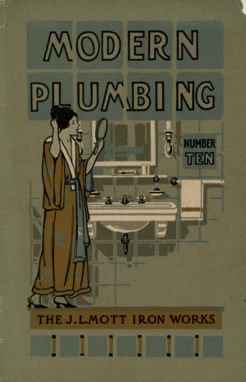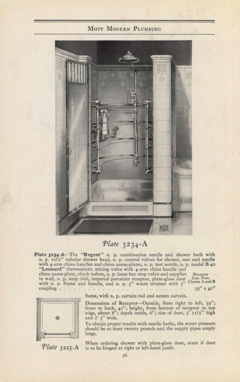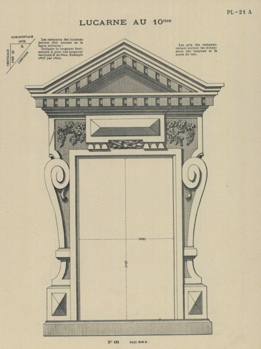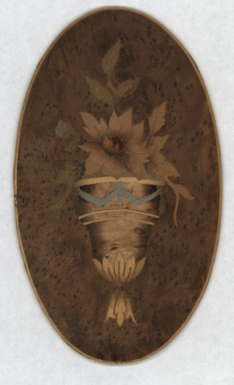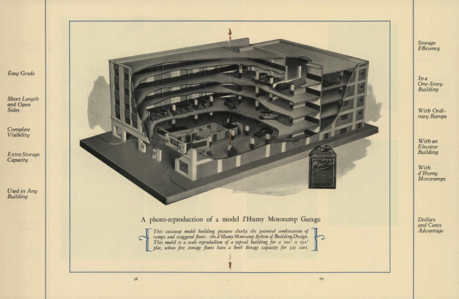By Catherine Essinger
In 2010 the University of Houston’s Architecture and Art Library began collecting a diverse array of historic retail brochures, pamphlets and catalogs related to buildings and the decorative products that once filled them. The collection features various paint and varnish pamphlets, as well as brochures from companies dealing in plumbing fixtures, fireplace heaters, tin roofing, furniture and more. Beyond product illustration, the images capture descriptive text, specifications and price lists. Most were published in the late 19th and early 20th century. While browsing the collection, one can observe American decorative style transition from the Victorian to Modern. Comforting catalogs of stick style house plans published in the 1880’s give way to sleekly appointed Art Deco bathrooms in a “Modern Plumbing” pamphlet published in 1921.
The collection includes small folios, substantial bound catalogs, and a nine panel folded brochure extolling the virtues of Curtis Kitchens. (“What a thrill when friends say – ‘I just love your kitchen,’” declares Mrs. America 1938 on the Curtis Kitchen brochure.)
The documents in the Architecture Retail Pamphlet Collection are extremely rare. Most are the only copy listed in OCLC. In order to increase access to the collection, they are gradually being digitized and made freely available online in the University of Houston’s Digital Library (digital.lib.uh.edu). At the time of this writing 21 are already available for viewing and 15 more will be ready near the end of March. This is a growing collection, so new materials will be digitized and made available for the next few years, as well.
Users may request high-resolution copies of every image in the Architecture Retail Pamphlet Collection. As all digitized materials are in the public domain, they may be used freely in research, teaching, and publishing, though we do request acknowledgement in any published works.
Some highlights from the current online holdings include:
J. L. Mott Iron Works. “Modern Plumbing #10.” 1921.
The J. L. Mott Iron Works was established in 1828, in an area of the Bronx now called Mott Haven. This sleek 49 page pamphlet offers fixtures and accessories for fashionable bathrooms and industrial kitchens.
L. Bonfils & E. Fesquet. “Ornaments En Zinc.” 1900.
One of the few European catalogs in the collection, the substantial edition from Paris includes zinc campaniles (cupolas), finials of all sorts and designs, corner mouldings, lucarnes (dormer windows), vases, girouettes (weathervanes), balustrades and lambrequins.
Raymond Bonnefond . “Marqueterie D’Art.” 1932.
In addition to the traditional Classical, fruit and floral, and jazz-era motifs one might expect from this catalog published in 1932, customers could order the visage of Lenin, Benito Mussolini, or French Prime Minister Raymond Poincare in marquetry. Veneer makes strange bed-fellows.
Ramp Buildings Corporation . “The Modern Garage.” 1929.
The Ramp Buildings Corporation was established in 1920. This 1929 booklet makes the case for that recent development, the “automobile hotel”:
The Modern Garage, as that term defines a mid-city building especially designed to house motor cars in numbers, is the tool of a new industry. Indoor Parking has become a national necessity. The mid-city Garage is, today, an institution of public utility and is recognized as such… The years to come may bring us multi-level streets and traffic boulevards which today appear in the haze of fantastic dreams. Whatever may be the relief for the congestion of moving traffic it is unquestionably a fact now and for indeterminate years to come, that the only possible alleviation of parking congestion is to provide space for storing cars for an hour, a day or a longer time, off the street. Thus, for the needs of today and the increasing needs of the future, man’s ingenuity has created the Modern Garage, and not as a luxury-priced necessity but as a sound economic utility.
Some other items already available online:
Berlin Iron Bridge Co.. “The Berlin Iron Bridge Co..” 1889.
Built-in Fixture Company. “Peerless Built-in Furniture.” 1926.
C. Schrack and Co.. “Architectural Varnish List.” ca. 1930.
Caldwell & Peterson Manufacturing Company. “Continuous Tin Roofing.” 1890.
Come-Packt Furniture Company. “Sectional Come-Packt Furniture.” 1912.
Glidden Varnish Company. “Jap-A-Lac.” 1890.
Homestead Heater Company. “Homestead Fires.” 1935. “Truly appropriate
fireplace heaters” – Cover.
M. Macdonald & Co.. “Steeplejacks.” 1920.
Murphy Door Bed Company . “The Murphy In-A-Dor Bed.” 1926. (sic)
Red Cedar Shingle Bureau. “Red cedar shingles: artistic and practical.”
Red Cedar Shingle Manufacturers’ Association. “Red cedar shingle.”
Scranton Lace Company. “Scranton: New outlooks for every home.”
Sears, Roebuck and Company. “How to paint.”
Shingle Branch of West Coast Lumberman’s Association/Shingle Agency of British
Columbia. “Distinctive homes of Red Cedar Shingles.” ca. 1910.
Wm. B. Gleason & Co. . “Natural Wood Ornaments for Furniture Maufacturers,
Architects, Builders,
Interior Decorators…: Illustrated Price List.” 1882.
Pamphlets being digitized as of this writing include several catalogs of early 20th century storefronts, metal ceilings and walls, mid-century windowalls, Art Deco and Moderne lighting, both American and British ironworks, and Arts and Crafts-style metal casements and stained glass.
Researchers will find new and developing collections on art and architecture from the College of Architecture’s rare books room whenever they visit digital.lib.uh.edu/aa. Expect new additions to the Architecture Retail Pamphlet Collection every few months. Our goal is to provide historians with a window into the evolving design styles available to customers in the U.S. and elsewhere in the 19th and early 20th centuries. Please contact archlib@uh.edu with questions or feedback about the collection.

 Study Architecture
Study Architecture  ProPEL
ProPEL 